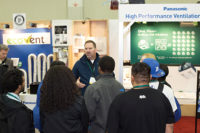
Attracted by the historic home’s original plasterwork, hand-stenciled ceilings, and milled details, a noted fine artist and her family became the new owners in 1998. The Willet Street home’s original mechanical equipment, the heart of which is a large steam heating system, would have provided a relatively high level of comfort for its time. While its steam heating still works well — with several modern upgrades — the home was built well before the availability of residential air conditioning.
The preceding owners would have tried to keep cool in the summertime using the passive approach: curtains closed during the day with windows open wide at night. Because her work was being affected by the high heat and humidity in her third floor studio, the new homeowner wanted air conditioning, but did not want to compromise the house’s historical integrity with a conventional cooling system, which, at best, would have required removing and repairing plasterwork, if not architectural details, to install ducts. Multiple window units also were not considered an attractive option.
The homeowner then learned about the Unico (St. Louis, MO) high-velocity mini-duct system from PBS’s “This Old House” program, which prompted her to contact Unico’s local manufacturers representative, Paul Ross Associates of Northampton, MA. Ross, in turn, referred her to Troy, NY-based contractor Enhanced Living, which specializes in heating and cooling systems designed for fine homes and estates.

OVERCOMING CHALLENGES
Bringing air conditioning to this home was no easy task. The project required its designer, Enhanced Living’s president and 30-year industry veteran Ed Bishop, and his installation team to apply creativity, while maintaining comfort, safety, quality, and efficiency of the system. Several challenges had to be overcome, including, first and foremost, maintaining the historical features of the structure.After working closely with the homeowner to determine the unique cooling needs of the home and carefully calculating the cooling load, Enhanced Living settled on Unico’s five-ton cooling system.
The attic would be the location of the system’s air handler, which sits in the center surrounded by a closed-loop supply trunk. According to John Bishop, who handles marketing for the contracting firm, installing the air handler and supply trunk required technicians to don Tyvek jumpsuits and respirators and spend two days in 100-degree-plus temperatures while wading hip-deep in blown fiberglass insulation. The two techs worked for 35 minutes at a time before taking a break. The homeowner helped out by providing an ample supply of cold bottled water.
Pathways for the 2-inch-ID mini-duct had to be found from the supply trunk to living areas on the first, second, and third floors. A small section of closet space serves as the central distribution point for duct running into rooms in the rear of the home, while a 1-1/2-square-foot plumbing chase running between the second and third floor bathrooms allowed enough space to run duct to rooms in the front. The supply outlets were positioned high along walls and on ceiling corners to maintain the manufacturer’s assurance of two-degree floor-to-ceiling temperature consistency in each room.

The return air grille was installed in the third floor hallway, just below the air handler in the attic. Finally, the system’s Coleman five-ton condensing unit was set on the home’s rooftop using an 80-foot crane rented from a local sign maker.
The installation was a success with the homeowner. The day following the system’s completion, she remarked to Ed Bishop that the new system allowed her husband one of the best night’s sleep ever since they moved in. She resumed her artwork in cool comfort and has used the home to entertain as many as 100 party guests without a complaint about the temperature.
The Bishops and the homeowner agree that the project would have been almost impossible using a conventional cooling system. But while mini-duct systems offer clear advantages to historic homeowners, achieving success in the historic retrofit market is not necessarily an easy sell to consumers. Such systems cost significantly more than conventional offerings. Ed Bishop believes that successful sales rest as much on the reputation of the contractor as it does on the benefits of the system.
“The retrofit market is generally comprised of smart, sophisticated individuals,” he said. “They read the literature and know the products before you even step into their home. The challenge for the contractor is to assure the client their historic treasure will remain one after the installation is complete. Unlike new construction rough-ins, there’s very little room for error on historic retrofits. You don’t want to be in the position of having to hire a master plasterer to fix your mistakes.”
Enhanced Living’s Willet Street project is a prime example of a successful historic retrofit made possible through high-velocity mini-ducts. The installation addressed the homeowner’s lifestyle needs, achieved the comfort desired, and helped contribute to the preservation of the home by making it livable for years to come.
Publication date: 10/21/2002


